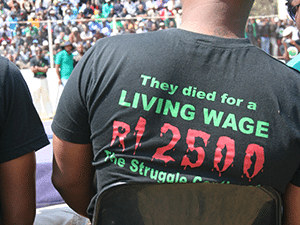
[miningmx.com] – WITH every major strike, one wonders where it will end? They create
major risks while very little is actually gained. In fact, there are losers on both sides; the only thing that
changes is the seriousness of the losses.
This realisation is greater than ever now the Association of Mineworkers & Construction Union’s
(AMCU’s) major strike at 75% of South Africa’s productive platinum capacity is a day away.
The strike at the gold mines – communicated by the AMCU on January 20 – is less serious. This proposed
strike is more strategic with the Chamber of Mines’ (CoM’s) three large gold-mining members and AMCU
attempting to outwit one another.
These mines are relatively financially robust, they are certainly not marginal mines. They may not earn as
much profit compared to levels of 2011, but this strike is not likely to cause them permanent damage,
unless the gold bosses dismiss their workers.
Conditions are quite different at the platinum mines of Anglo American Platinum (Amplats), Impala
Platinum (Implats), and Lonmin.
Strikes in the platinum sector are emotionally charged especially in the wake of the Marikana massacre in
2012.
The scandalous way in which the National Union of Mineworkers (NUM) has over the years used workers
at platinum mines as cannon fodder for political careers and corruption also heightens emotions in the
sector.
Most importantly, however, strikes in the platinum sector are informed by the hopeless existence of
poverty that goes on there even though they are right in the middle of one of the most valuable mineral
regions on the planet.
The essence of the strikes is a demand for a basic salary of R12,500 per month – an increase that in many
cases would result in a doubling of the workers’ current wages.
This demand was printed in red in the shape of drops of blood on the back T-shirts of AMCU members for
the commemoration of the Marikana massacre last year. “They died for a living wage – R12,500. The
struggle continues,’ the words on the shirts say.
AMCU says it did not formulate the demand. It’s a figure that the so-called worker committees decided on
in the months after the Marikana massacre. However, in an effort to halt the widespread unprotected
strikes after the Marikana massacre, AMCU commandeered this demand on behalf of the workers.
During the wage negotiations, AMCU made it clear that it did not expect platinum companies to comply
with the demand immediately. However, there had to be some progress toward a basic salary of R12,500
in two or at most three years’ time.
Impala Platinum (Implats), the first major platinum company that recognised AMCU as the representative
union, is the only company that tried to achieve this. Implats offered increases of 8.5% for this round of
negotiations and two further increases of at least 8% in the next two years.
These increases are significantly higher than the expected inflation rate over the three-year period. By the
end of the third year, the total of the four wage components – the basic minimum wage, the living-out
allowance, the company’s contribution to retirement funds, and the annual holiday bonus – will come to
R12,500/month.
AMCU did not approve of this, but at one stage it adjusted its demand to a basic salary of R8,000 that
must be reached this year.
STAKES RAISED
For AMCU there is a lot at stake. It became the majority union at platinum mines in difficult
circumstances, but great expectations have been set with which it must comply.
The settlement of 9.5% that the National Union of Mineworkers (NUM) reached with Northam Platinum
on Friday (January 17) gives a strong indication of what the other three are willing to pay, especially if it
can lead to an agreement without a strike being called.
Workers are Northam had been on strike for over 11 weeks – which included the Christmas holidays. It
will have serious repercussions for NUM if AMCU negotiates the same increase, or even a slightly better
one, at the other three with a short strike or perhaps even no strike at all.
“If AMCU comes to us today and demands an increase of 9.5% to 10.5%, we will sign immediately. We
will still have to convince the board about this, but if it happens without a strike, that won’t be too
difficult,’ a senior official at one of the three platinum giants said.
However, a prolonged strike at the big three could be devastating for mineworkers, who will undoubtedly
vent their disillusionment on AMCU. But the three major platinum producers can gain alot by a
prolonged strike – it will significantly reduce the supply of metal to the world market and push the price
of platinum up substantially.
For loss-making mines, it could even be better not to produce now, because they would have little or no
running costs during the strike.
Strikes at platinum mines were known as notoriously violent occurrences long before Marikana. AMCU
has built up a reputation in the coal industry and chromium mines that its strikes are always disciplined
and peaceful.
However, there are many signs of a so-called “third force’ that is trying to disrupt labour relations at the
platinum mines – several assassinations and the recent incitement of rebellions against AMCU are
unmistakable signs of this. In these circumstances, the possibility of renewed violence can certainly not
be disregarded.
The mistake that many people make is to think that workers will simply join NUM again if they feel
AMCU has let them down.
The disillusionment with NUM is far too great. If AMCU loses the confidence of platinum mineworkers,
they will form their own worker committees again – an anarchic system of control with which
communication is almost impossible.
Go and ask the mediators who tried to reason with these committees after the Marikana massacre. It could
mean the end of our platinum mines.











